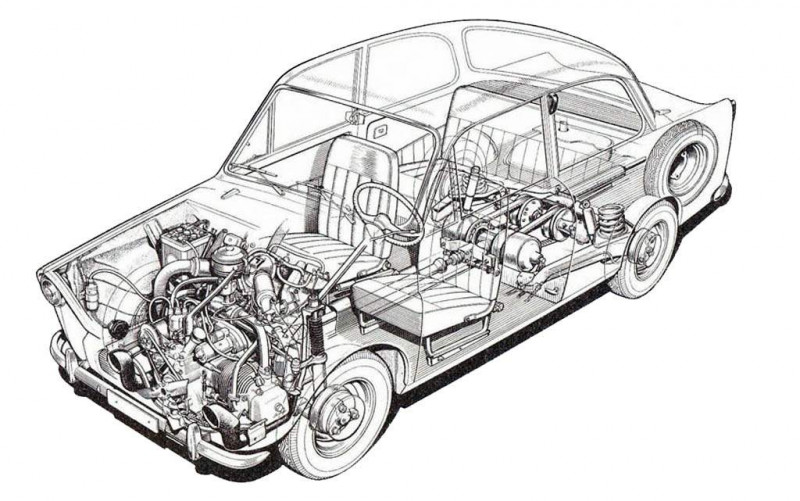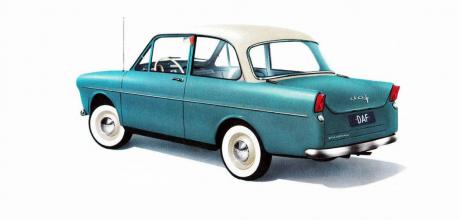First production-series car with CVT 1958 DAF 600
CVT. It’s probably one of the most divisive acronyms in motoring today. For some, the CVT – or continuously variable transmission – is seen as a means of smoothing gearshifts and curbing fuel consumption. Others can only wince at the system’s tendency to turn their driving experience into a drone some affair punctuated with the sensation of gear slip and sluggish performance.
Whichever side of the fence you occupy, it has to be said, CVT is one of the most interesting innovations in motoring and its history predates that of many automotive technologies. Whereas most innovations can trace their roots back to the early 20th century, perhaps the late 1800s at a push, CVT’s origins can be traced back to the father of the Renaissance – none other than Leonardo da Vinci – more than 500 years ago.

Variomatic CVT was integrated with the rear suspension, and all of its elements were not covered by any protective covers, which also did not add reliability to it.
Back in 1490, he conceived an idea for a gear set that did away with multiple cogs and instead used a splined roller that could be manipulated to provide a seemingly limitless degree of ratios. Although many manufacturers did attempt to develop CVTs for limited runs, it was Dutch automotive firm DAF (still famed for its trucks) that put the idea into mass production in 1959, by applying its proprietary Variomatic CVT system to the small DAF 600 sedan. DAF’s assembly employed a cone pulley-and-belt arrangement connected to an array of centrifugal weights driven by a combination of engine speed and manifold vacuum – the difference between atmospheric pressure and the air pressure in the engine’s intake manifold – to move the belts along the pulley cones. While the 590 cc flat-twin- engined 600 was never going to set any performance records, its Variomatic CVT was a smooth operator and endowed the quirky little sedan with some unique driving characteristics. For instance, the limitless gear ratios applied to both forward and reverse operation enabled the car to travel just as fast in reverse as it would in drive. Because its manifold vacuum-driven CVT could shift the variable pulleys into higher ratios with no impact on engine revs, the system allowed the car to travel faster by gently easing off the throttle once the revs topped out – from 97 km/h to 110 km/h – given enough time on a level surface. A switch on the 600’s dash also reversed the action of the manifold vacuum on the diaphragm that modulated the pulleys, providing a form of engine braking by lowering the pulley-to-pulley ratio as manifold pressure increased.

Pay attention to how much space the variator takes up
The DAF 600 saw only four years of production, but its Variomatic system would spawn further developments in CVT technology. With time and share divisions in the company heading the way of Leyland, Paccar and Bosch, the variants would go on to find their way into models from manufacturers such as Audi, BMW Mini, Honda and Subaru; its smooth operation and fuel efficiency found favour with compact models and hybrids in particular.
THEY ALSO PAVED THE WAY
1901 BOLLÉE TYPE F TORPEDO
French carmaker Am.d.e Boll.e invented an arrangement that replaced the clutch pedal with a ring mounted inside the steering wheel of his Type F Torpedo car. This made it the precursor to the now-common paddle shifter.
1939 OLDSMOBILE SERIES 60
General Motors’ Hydramatic was the first production series automatic transmission that used a torque-converter system to shift gears without the use of a manual clutch; the four-speed variant was offered as an option on the Oldsmobile.
2003 VOLKSWAGEN GOLF R32
The R32 was famed not only for its sonorous 3,2-litre naturally aspirated V6 engine, which produced a form-idable-for- its-time 177 kW and 320 N.m, it was also the First mass-produced car to feature a fast-shifting dual-clutch transmission.
2013 BMW i8
While many consider the likes of the e-tron and Taycan to be trailblazers in the shift from single to two-speed transmissions for their electric motors, GKN automotive developed such a system for the electric front motor on the i8 back in 2013.


